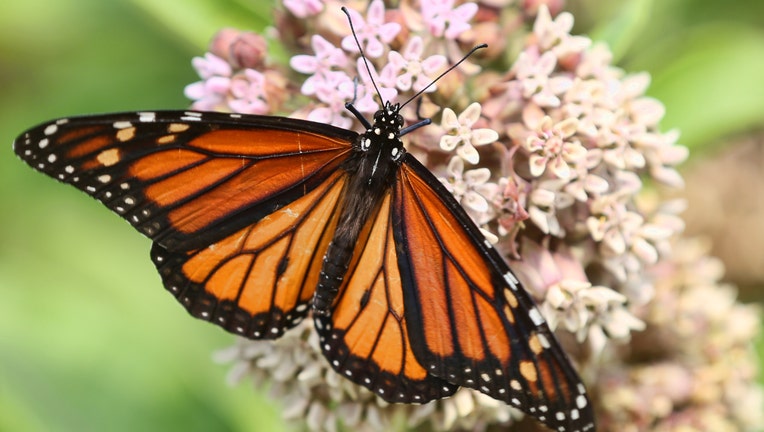Study: Monarch butterflies could thrive in southern Great Lakes amid declining populations

Monarch butterfly (Danaus plexippus) on a milkweed plant flower in Toronto, Ontario, Canada, on July 08, 2022. (Photo by Creative Touch Imaging Ltd./NurPhoto via Getty Images)
(FOX 2) - A new study out of Michigan State University bolsters predictions that the warming from climate change will exasperate the pressures on Monarch butterflies, which are already hampered by extreme temperatures and drought.
Declines in the overall population of Monarch butterflies over the next several decades will be driven by an increase in temperatures in the places where the butterflies are known to breed.
But in the Midwest, where climate change isn't expected to generate as extreme temperatures and may even add to the location's rainfall totals, Monarch populations could stabilize or even grow.
Researchers said areas like northern Ohio in the southern Great Lakes may become one of the best places to promote butterfly growth. Protecting these areas by restoring grasslands and planting more milkweed plants could become key factors if conservationists hope to sustain Monarch butterfly populations.
Monarch Butterfly Migrations
The study, which was co-authored by Dr. Erin Zylstra and Dr. Elise Zipkin at the Michigan State University Department of Integrative Biology, as well as Dr. Naresh Neupane at the Department of Biology in Georgetown, focused on the eastern migratory population of Monarchs.
Western Monarchs like to migrate to the California coast for the winter and sometimes travel north to other western states. Eastern Monarchs are the species that make the well-known thousand-mile journey from the Midwest to Mexico.
A Monarch butterfly goes through multiple generations in a year. By the time they migrate south, many have gone through two or three lifespans. They emerge between July and October before they start their trip south. Eventually they settle in Mexico and Texas.
MORE: Here's the best way to see Michigan's fall colors
That same generation then begins returning in March, laying eggs as they travel. They eventually make it into the Corn belt by late April and May, then reach the Midwest in the summer.
Climate change effects
The range of migration that Monarch butterflies have and the series of generations they undergo in a year make studying them particularly tricky since they travel the much of the North American continent.
Because global warming affects geographies differently, the range of impacts on different cycles of the butterfly can vary. The temperatures where butterflies spend most of the winter months are expected to get hotter due to global warming than where butterflies spend the summer months.
"Long-term population declines are likely to be driven by increases in spring breeding-season temperatures, as climate in eastern Texas has hard significant effects on monarch abundance," the study reads. According to the study, the temperatures in Texas will heat up "dramatically" in the second-half of the 21st century.
That could create big problems for the spring breeding butterflies that stop there during migration.
But in the Midwest, it's a bit less certain. The study looked at how Monarch populations faired in scenarios where emissions rose by a lot and by a little.
MORE: Rare white black bear caught on Michigan trail camera
In places where temperatures aren't predicted to change as dramatically, which includes states that border the Great Lakes like Indiana, Michigan, and Illinois, the effects on the butterfly population won't be as stark. In some parts like northern Ohio, their populations could even grow.
But in northern parts of the Midwest like Minnesota, population declines are expected to be the most severe among summer breeding butterflies.

